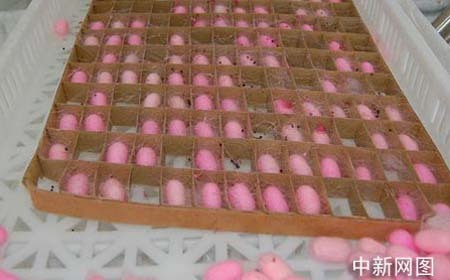China has been raising silkworms on a diet of mulberry leaves for 5,000-years to produce white or yellow silk cocoons.

Pink silkworms nibble away at their artificially produced meal on Tuesday, June 3, 2008. The Wujiang Agriculture and Forestry Bureau in Jiangsu Province began experimentally substituting the traditional diet of mulberry leaves with a man-made food on May 2. [Photo: cnsphoto]
But now, a group of farmers from Wujiang in Jiangsu Province have introduced an artificial diet to produce pink silkworms.
A senior agriculture expert, Zhu Yingen, told the China News Service on Tuesday that the local agriculture and forestry bureau began this trial silk production method on May 2nd.
And one month later, the pink cocoons produced by the worms proved the trial successful.
One obvious advantage of the artificial diet is that this special diet is not constrained by the seasons as is the mulberry leaf diet, which is only available during the spring and summer months.
The artificial diet will allow for year round silk production, but at the price of higher production costs.

Pink cocoons produced by silk worms fed with a man made diet in this June 3rd photo. [Photo: cnsphoto]
(CRI June 4, 2008)